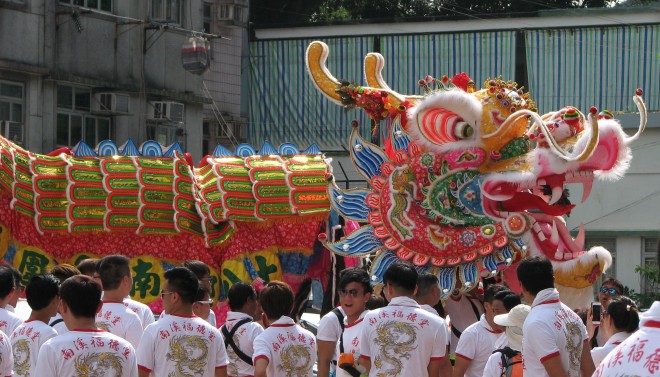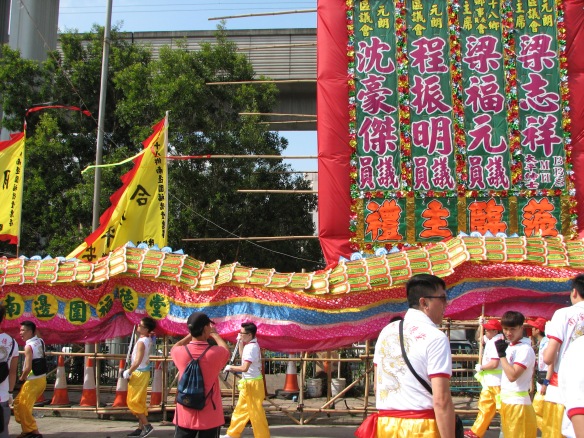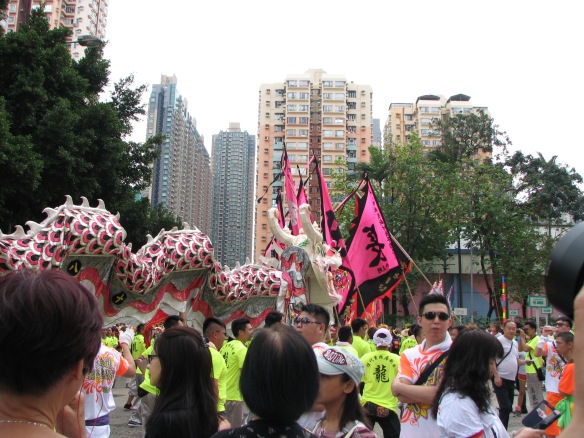JRR Tolkien was born on January 3, 1892 in Bloemfontein, Orange Free State, South Africa. He is of course reknowned for The Silmarillion, The Hobbit, and The Lord of the Rings trilogy, for which he invented complex alphabets and histories for elvish, dwarvish, and other tongues. Tolkien taught at Oxford, England where he became close friends with fellow scholar and author C.S. Lewis. I once heard a story (I’d love to believe that it’s true), that the two professors were observed in a deep debate that went on for hours. Finally the observer gathered his courage and approached: what, might he ask, were the two men so fiercely arguing about?
“The characteristics of dragons,” they answered, and promptly went back to their discussion.
In Tolkien’s honor I am reprinting the post I wrote after seeing a dragon parade for the goddess Tin Hau in the New Territories of China.

Tin Hau is the Goddess of the Seas, patron saint of sailors and fishermen throughout China and Southeast Asia. [1, 2]
Her festival is always held on the twenty-third day of the third lunar month of the lunar calendar. My friend Weiyu flew over from Beijing, and we had the good luck to see a dragon parade. [3]
Lin Moniang (don’t forget that Chinese put the family name first) was born March 23, 960 in the Song Dynasty, on Meizhou Island in Fujian, China. She was the seventh daughter, an excellent swimmer, and wore a red dress. No matter how bad the weather was, Lin Moniang stood on the shore in that red dress in order to guide the fishing boats back home. She went into a trance during a terrible storm and saved her father’s life.
She was deified not long after she died.
There are many reports of miraculous sightings of Tin Hau by sailors in distress. Chinese who immigrated often built temples once they arrived overseas to thank her for the safe journey.
Each year a major festival is held on her birthday. One of the most spectacular is in Yuen Long in the New Territories. Weiyu and I headed out early to reach the town. We left the metro station and immediately spotted bright colors and a crowd of people. As we got closer, firecrackers began to go off! We’d arrived right on time!

The village had just begun to parade their dragon. They circled the lot a few times accompanied by a loud drum and cymbals. There was another loud bang, more firecrackers popped, and everyone followed the dragon into town.
We arrived at another square where more dragons waited.
The dragons took turns weaving up and down the main street, curling and snaking, rising and falling in an intricate dance. Sometimes two dragons danced at the same time.
People’s shirts indicated which village and dragon they were with. Groups of old women waved fans, children were in costume, and I saw lions.

Flags and banners waved around the Fa Paus: ornate towers with paper flowers. Huge elaborate placards wished for luck and prosperity.

Offerings included entire roasted pigs.
I recognized those roast pigs instantly from the worship of goddess Bà Chúa Xứ in southern Viet Nam. It can’t be a coincidence that her festival starts at the beginning of the rainy season on the twenty-third day of a lunar month too…
In memory of JRR Tolkien, 3 January 1892 – 2 September 1973
NOTES: [1] Tianhou (天后) literally means “Empress of Heaven”. [2] She’s also known as Mazu, Tian Fei or A-Ma. Buddhists conflated her into a reincarnation of Guan Yin, Goddess of Compassion. [3] She has over 90 temples in Hong Kong alone. Photos and text © 2015 Jadi Campbell. Previously published as Adventures in China’s New Territories 2: Dancing Dragons. Pictures from our trips to Vietnam and China and Uwe’s photography may be viewed at viewpics.de.
Click here for my author page to learn more about me and purchase my books.





























 We tried to see some of the incredible nature, too. My personal highlight was Sarawak on Borneo. We went to the UNESCO global geopark on Langkawi Island and took a bus inland to the tea country of the Cameron Highlands.
We tried to see some of the incredible nature, too. My personal highlight was Sarawak on Borneo. We went to the UNESCO global geopark on Langkawi Island and took a bus inland to the tea country of the Cameron Highlands.



 We explored many of them and I was delighted and calmed by the sweet atmosphere in these roads. The world feels more and more divided. But the Malaysians we talked with are proud of the religious tolerance and multicultural blend that makes up their country.
We explored many of them and I was delighted and calmed by the sweet atmosphere in these roads. The world feels more and more divided. But the Malaysians we talked with are proud of the religious tolerance and multicultural blend that makes up their country.


 And that’s a concept I’ll gladly raise a glass of wine to….
And that’s a concept I’ll gladly raise a glass of wine to…. NOTES: © Jadi Campbell 2019. All photos © Uwe Hartmann. To see more of Uwe’s pics from Malaysia and our trips go to
NOTES: © Jadi Campbell 2019. All photos © Uwe Hartmann. To see more of Uwe’s pics from Malaysia and our trips go to 
